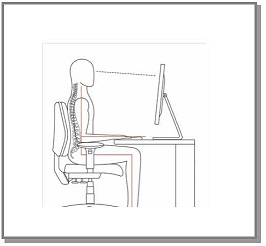NAOSH Day 2: Office Ergonomics
Tuesday May 6, 2014
Ergono,mics is fitting the task to the employee. It is aimed at ensuring that equipment, tools, and job tasks are properly designed and/or arranged to minimize the risk of injury, to reduce discomfort and to promote efficiency.
Many Humber staff use computers regularly throughout the day. Sitting for extended periods of time at a computer workstation in poorly designed/adjusted equipment, and in awkward postures can introduce a number of ergonomic risk factors that can lead to musculoskeletal pain and discomfort, as well as eye strain.
Please review the following general office ergonomics guidelines as they relate to your own computer workstation:

- Chair height should allow your feet to rest flat on the floor or on a foot rest, with your thighs roughly parallel to the floor.
- There should be about two inches of space between the front edge of the seat and the back of your knees.
- You should be able to maintain contact between your back and the chair’s backrest while working on the computer to allow proper back support.
KEYBOARD/MOUSE POSITION:
- Your elbows should be bent at about a 90 degree angle when your fingers are on the home row of the keyboard, with your upper arms hanging naturally from your shoulders.
- When using a mouse, your wrist should be in a neutral position.
- The mouse should be located beside the keyboard, and you should be able to move it freely on the work surface.
MONITOR AND WORKSTATION:
- Position the monitor about an arm’s length away; and the top of the monitor should be at, or slightly below, eye level.
- Regularly used equipment, such as a phone or files, should be located within an arm’s reach.
- When computer work requires entering information from source documents, document holders should be located beside the screen and on the same plane.
- There should be adequate leg-room under the desk.
LIGHTING:
- Too much or too little light, or glare on the screen can have an impact on your eyes.
- Task specific lighting and appropriate brightness settings on the computer itself are important to consider.
Remember to vary your posture and tasks throughout the day to reduce fatigue and discomfort. To obtain further information, or to fill out our Office Ergonomics Self-Assessment Checklist, click here.
Thank you for reviewing this information. Tomorrow’s message will focus on Slips, Trips and Falls, and remember that Friday’s message will offer the opportunity to win prizes!
HR Services | Health and Safety Services
NAOSH Week is led by the Canadian Society of Safety Engineering (CSSE).
More information about NAOSH Week can be found at www.naosh.ca or www.csse.org.
